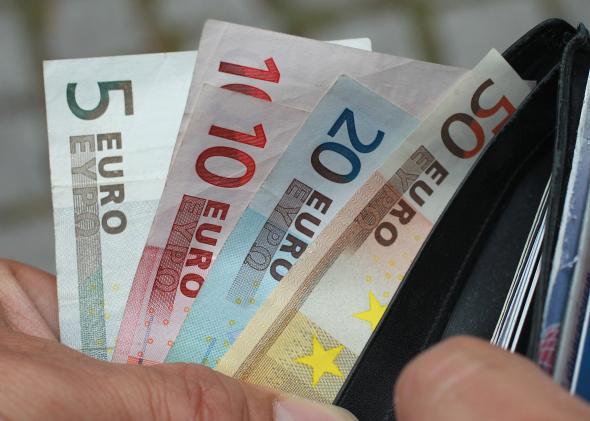Planning a trip to France or Spain this summer? If so, congratulations: The world’s financial markets have smiled upon you. The euro is in the midst of a spectacular freefall—down 12.4 percent against the dollar since January, and down about 24 percent over the year—that could soon leave it worth less than the greenback for the first time since 2002 (at the moment, it’s trading around $1.05). Where will the slide end? Deutsche Bank, for one, thinks that the shared currency could eventually bottom out at $0.85. For American tourists, buying a glass of wine in Paris is becoming cheaper by the day.
This is wonderful news for Europe. But cut-rate vacation options aside, is it good for the United States? That’s a slightly trickier question.
There are a few reasons why the euro has been falling so rapidly against the dollar. First, the European Central Bank has finally begun its quantitative easing program, buying government bonds in order to push down their yields. With interest rates in Europe falling to record lows, investors are looking to park their cash in places like the United States, where they think they can get a better return. With money flowing out of Europe, the euro is depreciating—which is exactly what the central bank wants. A cheaper euro, after all, should help Germany, Italy, Greece, and the rest of the currency area sell more exports and boost the region’s anemic growth.
While policymakers in Frankfurt are doing everything they can to push the euro lower, the world’ s markets are doing their part to drive the dollar higher. Compared with the rest of the globe, the U.S. economy is growing at a fairly healthy pace, and interest rates on bonds here are somewhat higher. That’s attracting more investment stateside. At the same time, low oil prices have improved our trade balance. Those factors are all contributing to a stronger dollar, which is rising not only against the euro, but also the British pound, the Japanese yen, and “almost every other currency in the world,” as Matt O’Brien notes. To some degree, we’re witnessing a snowball effect: As the dollar’s value goes up, it attracts more investment, and spirals ever higher.
A strong dollar can be both a blessing and a curse for the U.S. economy. On the one hand, it means cheaper imports, which consumers love. Families will save money on clothes, cars, electronics, coffee, some really delicious cheese, and all sorts of other staples. On the other hand, a supercharged currency will make it harder for us to sell our own goods abroad. While exports aren’t quite as crucial to our economy as they are to Europe’s, for instance, they’re still important. As they fall, it could cut into job growth.
Whether the dollar’s boom turns out to be a net plus or a drag could depend on how the Federal Reserve reacts. With unemployment dropping, Janet Yellen & co. are widely expected to raise interest rates some time this summer in order to head off inflation. The problem is that a hike would strengthen the dollar further (again, higher interest rates attract investors, and as investors pile into a currency, it appreciates). At the same time, just like low oil prices have kept a lid on inflation these past several months, cheap imports should keep prices from rising in the near future. So theoretically, the strong greenback gives the Fed two very, very good reasons to remain at bay, by keeping inflation in check and threatening to curtail exports. If that’s enough to keep our central bankers from pushing the button on higher rates, it could also allow for additional time for the unemployment rate to drop and for wages to rise—which is probably something most Americans would appreciate far more than a cheap Euro trip.
